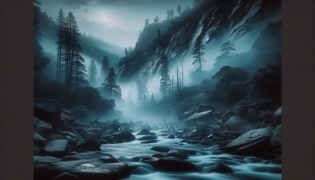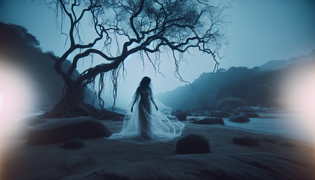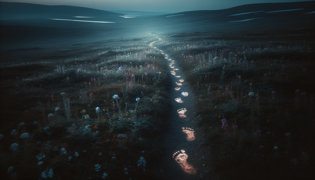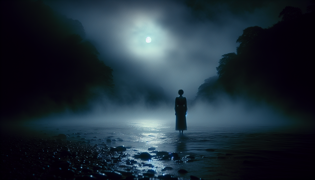Introduction
Rio Frio Valley stretches along the rugged western border of Texas, where limestone bluffs meet gullies fed by a gently flowing river. By day, the valley seems serene, its cedar and oak trees casting long shadows across dusty trails. But when twilight falls and mist drifts in from the water’s edge, an otherworldly presence awakens. Long before paved highways and power lines carved through this landscape, it was known only to a handful of ranching families and wandering prospectors. It was here, beneath a harvest moon in the early years of the twentieth century, that Maria Cortez met a fate as cruel as the winter wind. She was born in San Antonio and brought to Rio Frio by a promise of safer work and sweeter days. She laughed among cottonwood branches and learned to brand cattle alongside her new neighbors. But love can be a fragile bloom on rocky soil, and envy sometimes grows in its shade. One night, a bitter quarrel ended with screams echoing across the riverbank and a single gunshot silencing Maria’s laughter forever. In the aftermath, her body vanished beneath brush and briar, leaving only footprints and whispered rumors. In the century since, strange shapes appear when the fog rolls in, phantom sobs drift on the breeze, and travelers swear they feel a breath of cold air against their neck. People speak her name when the wind picks up at dusk, calling her back or warning her away—as though the boundary between what is alive and what remains is less than a heartbeat.
Whispers in the Mist
For generations, locals have reported hearing soft murmurs drifting out of the Rio Frio fog long after sunset. Some say it begins as a faint lullaby, carried on the river’s breath, then swells into desperate cries for justice. Ranch hands brushing through tall grasses at dawn speak of footprints that bloom in the dew—but fade the moment you step closer. One night, the Huddleston ranch foreman, Eli Grant, followed the sound of sobbing across his pasture. He carried only a lantern and a hollowed-out curiosity, but what he found changed him forever. Beneath a clump of paleflower bushes, he saw a woman in white, kneeling by a shallow pool of water as though washing her tears. Her hair spilled over her shoulders, damp with the morning mist, and she raised her head as if someone had called her name. Eli’s lantern flickered, his breath caught, and when he dared to step forward, the figure dissolved into ghostly tendrils that drifted away with the fog. He abandoned his lantern, left the keys to his pickup on the porch, and refused to return to that valley floor for years.
Across the ridge, grandmothers spin warnings around potbelly stoves: don’t wander alone when the moon is low. The story adapts itself to every listener. Travelers who camp by the river bank awake to soft footsteps circling their tents. Horses bolt, hooves pounding as though ridden by an unseen rider, and old dogs howl at shadows that flicker—then vanish. Families from nearby towns cross themselves and invoke Maria’s name, pleading for mercy or for her spirit to find peace. Nothing can silence the whispers; nothing can stop the mist from gathering.

[Image: mists-of-rio-frio.webp]
At the heart of the valley, a narrow footpath winds between limestone outcrops and spindly cedars. During harvest season, workers hurry past that trail, fearing the weight of unseen eyes. One autumn, a self-proclaimed skeptic named Luis Castillo set out at dusk to disprove the legend. He carried a coil of rope, a notebook, and a flask of whiskey. He laughed at the idea of a wandering ghost until a cold gust raked through the canyon, extinguishing his lantern and draining the warmth from his bones. In the starlight, he saw her silhouette standing above him on a ledge so steep it should have been impossible to climb. She stared until his knees buckled, then whispered his name with a voice that sounded both hopeful and resigned. He swore he felt her hand brush his cheek before an icy wind yanked him to his feet and sent him running back to town with hair turned white overnight.
Every retelling adds another detail: a song she once sang, a locket lost in the river, a silver comb found tangled in weeds. And so the mist carries Maria’s story through the valley, allowing each new generation to glimpse her sorrow and wonder if they might offer her the peace she never found in life.
Echoes of Tragedy
The details of Maria’s final night have blurred across time, but the pain remains vivid in every telling. In 1908, a traveling salesman named Thomas Bannon arrived with promises of trade and a carriage full of curiosities. He charmed Maria with foreign trinkets and smooth words, but beneath his practiced smile was a restless cruelty. When she refused to join him on a midnight ride to the county seat, he flew into a rage. Witnesses later claimed they heard Maria’s voice carried on the wind—pleading, bargaining, begging—until a single gunshot rent the air.
Her body was never found, though neighbors searched with lanterns and hounds for days. Some said she was buried under an old railroad tie or hidden behind a dry stone wall. Others whispered that Thomas disposed of the evidence in a deep channel of the river where currents run strong. Yet every year, on the anniversary of her disappearance, a pale figure drifts along the water’s margin, combing the shoreline with hollow eyes. Those who know the story avoid the river that night, believing Maria still seeks the locket he tore from her dress—the only memento of their brief romance.

[Image: maria-silhouette.webp]
Recent visitors have left offerings: strands of white ribbon tied to cypress branches, small bouquets of desert roses placed on boulders by the trail, hand-scrawled notes asking for forgiveness or urging her to move on. Some are returned overnight, stripped of petals, ribbon cut and strewn at the river’s edge. Ranch wives report waking to find the bedroom door pushed open, a cold breeze swirling through lace curtains even when windows are sealed. And when the wind howls between the mountains, it carries not only her sorrow but a faint two-part harmony—as though she sings to herself in an attempt to hold on to a memory that keeps slipping away.
Today, historians comb through archived newspapers and legal documents, piecing together fragments of Maria’s life. They uncover letters written in spidery script, pardons unfiled, and maps with her favorite wildflower patch marked. Yet the valley resists complete explanation: headlines fade, paperwork decays, and only the fog preserves the outline of her grief. Maria’s echo remains woven into every gust of wind and every droplet of morning dew, reminding all who pass that some wounds refuse to close until justice is done.
The Restless Journey
Each spring, flush with bluebonnets and crimson Indian paintbrush, the valley awakens with new life—yet Maria’s spirit endures, unchanged by the seasons. Hikers following the old county map discover fresh footprints that lead away from beaten paths, trailing into mist-shrouded glades where no living soul dares tread. Some brave souls leave cameras to record her passage, only to find the memory cards blank or filled with static streaks. Others swear they see her reflection in still pools even when no one else is around: a woman with hollow cheeks, wide eyes that glimmer with longing, and a dress that sways as if touched by an unseen hand.
Legend holds that Maria tries to retrace her last steps in search of something lost or buried. At dawn, the first rays of light reveal faint impressions in soft earth: footprints heading east toward an abandoned well, heading west up treacherous ridgelines, then disappearing altogether. Visitors leaving tokens—coins, silver buttons, tattered love letters—often wake to find them scattered across the campsite, as though she’s carrying them somewhere beyond sight.

[Image: haunted-steps-rio-frio.webp]
Occasionally, a traveler reports sudden exhaustion when dusk nears, even on flat, easy trails. They describe their legs growing heavy, their vision swimming with half-remembered memories of loss. In that state, they’re prone to hallucinations: glimpses of a pale lady beckoning from behind a twisted cottonwood, a faint lullaby drifting on the wind, or an unearthly chill that travels from the riverbank up their spine. Some have tried to speak her name aloud only to find their voices stolen by the darkness.
Despite the fear she inspires, countless visitors remain drawn to Rio Frio, hoping to witness a piece of the legend. They arrive with lanterns, journals, and a flicker of hope that they might somehow ease Maria’s anguish. Even skeptics, convinced of rational explanations, find themselves unsettled by the valley’s quiet persistence. For in Rio Frio, the boundary between past and present thins until every rustle of leaves and every murmur of water becomes a reminder: some spirits cannot rest until their story is heard and their love is acknowledged.
Conclusion
As dawn breaks over Rio Frio Valley, the mist retreats and the world seems to exhale. Yet those who linger beyond sunrise carry Maria’s presence with them, in the quickened heartbeat of a sudden breeze or the way shadows cling to the edges of vision. The legend of the White Lady endures because it speaks to something timeless: the yearning for justice, the ache of unspoken love, and the hope that even in death, a soul might find a voice. Each whispered rumor and each trembling photograph keeps Maria’s memory alive, reminding all who wander these hills that some stories refuse to fade. Whether you seek her out or stumble upon her by accident, remember to tread lightly, speak her name with kindness, and leave behind whatever you can—an offering, a promise, a shared moment of compassion. For it is in our willingness to remember and honor those who came before us that we allow their spirits to finally rest. And perhaps, just perhaps, the White Lady of Rio Frio will sigh in relief and fade into the dawn, her vigil complete at last.


















